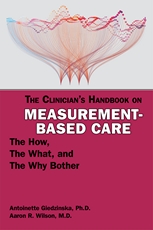Quality Indicators
Defining and Measuring Quality in Psychiatric Care for Adults and Children (Report of the APA Task Force on Quality Indicators)
View Pricing
Description
The past decade has witnessed remarkable growth in the field of quality measurement in health care. Today's patients want to know that the care they receive is safe, effective, and accessible.
This compelling monograph combines—for the first time—the reports from two American Psychiatric Association task forces on quality in psychiatric care (March 1999, which focused on adults, and October 2001, which focused on children and adolescents), offering a clinical framework for quality measurement that provides sample indicators of quality for health plans, facilities, and systems of care.
Using similar formats and definitions, each task force considered a matrix of priority areas of care, including specific patient populations (e.g., elderly, seriously and persistently mentally ill, developmentally disabled people) and diagnostic categories (e.g., depressive disorder, schizophrenia, substance use disorders). Each then examined important aspects of patient care and constructed a quality framework that included dimensions of access, quality (appropriateness of care), perception of care (satisfaction), outcome, and—for the children's report—prevention.
Each task force also considered relevant methodological issues: cultural, linguistic, and ethnic differences; data collection and tracking; confidentiality of data; risk adjustment; use of rating scales and standardized instruments; and designation of standards.
Sample recommended goals include
- For adults: patients with serious and persistent mental illness should have access to newer generations of antipsychotic medications as these become available; patients should achieve a significant reduction in symptom.
- For children and adolescents: the mental health status of children and adolescents should be assessed annually; children with severe or persistent mental illness whose care involves multiple child-serving systems, caregivers, and service providers should have their care coordinated
Sample indicators include
- For adults: utilization of new antipsychotics for patients with the diagnosis of schizophrenia; reduction in frequency of panic attacks in patients with the diagnosis of panic disorder
- For children and adolescents: high levels of satisfaction of adolescents using mental health services or substance abuse services; reduction in a family's stress level and impact of illness
As the initial step in what must be an evolving effort by clinicians to define, measure, report, and improve the care that patients and their families receive, this monograph is essential reading for those who provide and receive care, accredit and regulate care, and purchase and administer clinical services.
Purchasers of mental health care want clear, reliable, meaningful, and comparable information on what care is provided and with what results. APA convened these two task forces to lend its professional expertise to that issue, to advise on how to develop clinically based, patient focused quality indicators that use existing and ongoing research and clinical consensus in selecting potential indicators.
Contents
- Introduction
- Part I: Report of the American Psychiatric Association
- Task Force on Quality Indicators
- Chapter 1. Executive Summary
- Chapter 2. Report of the Task Force on Quality Indicators
- Part II: Report of the American Psychiatric Association
- Task Force on Quality Indicators for Children
- Chapter 3. Executive Summary
- Chapter 4. Report of the Task Force on Quality Indicators for Children
- References
- Acronyms and Abbreviations
- Glossary of Terms and Definitions
- Index of Quality Indicators by Topic
- Index of Surveys, Rating Scales, and Instruments
- Index to Report of the APA Task Force on Quality Indicators
- Index to Report of the APA Task Force on Quality Indicators for Children
Related Products
Carousel Control - items will scroll by tabbing through them, otherwise arrows can be used to scroll one item at a time







